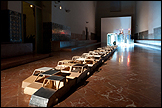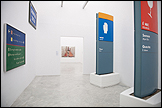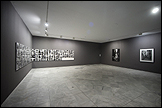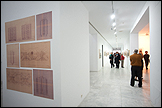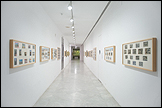Cities,
like people, can be recognized by their walk
Date: 24 November 2011 -
4 March 2012
Curator: Luisa López Moreno y Juan Antonio Álvarez Reyes
Exhibition Session: Margin and City
Tete Álvarez · Olivo Barbieri · Sergio Belinchón ·
Juan Sebastián Bollaín · Miguel Brieva · Santiago Cirugeda
· Joan Colom · Peter Downsbrough · Peter Frield
· Federico García Lorca · Nan Goldin · Paco Gómez
· Dan Graham · José Manuel Guerrero Sánchez ·
Gervasio Iglesias · Juande Jarillo · Juan Ramón Jiménez
· Francesco Jodice · Gonzalo Juanes · Rem Koolhaas
· Fritz Lang · Zoe Leonard · Rogelio López Cuenca
· Alex MacLean · Ramón Masats · Xavier Miserachs
· Ryuji Miyamoto · Luis Molina Pantin · Pedro
Mora · Daido Moriyama · MP&MP Rosado · Nazario
· Francisco Ontañón · Jesús Palomino · José Miguel
Pereñiguez · Carlos Pérez Siquier · Guillermo Pérez
Villalta · José Miguel de Prada Poole · Xavier Ribas
· Juan Carlos Robles · El Roto · Francesc Ruiz
· Alberto Schommer · Miguel Trillo · Julio Ubiña
· Madelon Vriesendorp · Jorge Yeregui · Claudio
Zulián
Stating that, as Robert Musil once wrote, "no special significance
should be attached to the name of the city", might be problematic
in a place as distinguished and openly proud of itself as Seville.
Although the author of The Man without Qualities was referring
to Vienna at a time of change, the use of this expression today in
Seville and in the context of an exhibition designed around one of
the central lines of the collection of the Centro Andaluz de Arte
Contemporáneo - which focuses on the city and the transition from
rural to urban - merely reflects an attempt to paint a broad picture
in the sense employed by Musil in his novel: obviously, "regarding
this much more complex entity that is the city where one lives, one
always wants to know exactly which particular town it is", but getting
caught up in each and every minor detail "distracts us from more important
questions". In this respect, like Vienna in Robert Musil's text, Seville
is at the heart of our exhibition discourse, even though we do not
wish to attach any "special significance" to its name.
Musil and his novel have also supplied the title of the exhibition, whose polysemy can lead us in three different yet interrelated directions. The first direction emphasizes the action, the act of walking itself as an aesthetic practice. The second focuses on the issue of time, for human and urban identity is constructed with the passing of years. And the third, more evangelical direction proclaims, "Ye shall know them by their works", meaning that one must experience how a city or a person acts in order to truly know them. Exploring, observing and experiencing are therefore essential for acquiring knowledge. By travelling in these three separate yet adjacent directions, we hope to explain the logic behind a temporary exhibition of the permanent collection that journeys from the concept of the metropolis to that of imaginary cities, from ordinary life in the city to the spectacle, and from the outskirts under construction to the tamed natural environment.
|
ADDITIONAL DOCUMENTATION |
